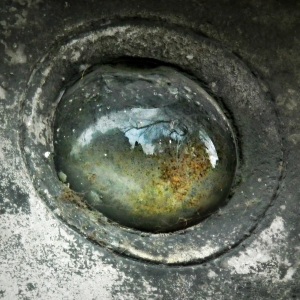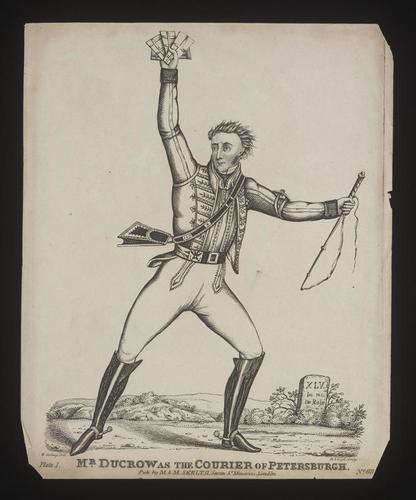Once we had stepped down the stairs of the Anglican Chapel we found ourselves surrounded by impressive tombs and mausolea. Now we were in the most prestigious area, the Centre Avenue, the spot to be buried. (if you could afford it, that is).
And suddenly I remembered that I had seen a very remarkable mausoleum online, in videos, on photos. I said to my friend "there is this truly amazing mausoleum and I feel it must be here! It is here!"
It was a bit odd that I suddenly remembered it and that I felt so strongly that we must be really close to it. I know the sceptics will say that it is not that odd after all because where to erect such a grandiose monument if not at the Centre Avenue. Nonetheless it was a strange moment. I am not saying I felt the presence of it but still it felt a little bit as if something did decidedly draw me to it. ("It is here! I know it!" ~ my friend can vouch for this occurrence)
And lo and behold ~ there it was.


Can you see the orb? A glass eye! A Victorian HAL 9000! A crystal ball! We were wondering if it was this thing sending out vibes which I had received. (Before someone starts to doubt our sanity ~ we were not entirely serious about this)
But why not allowing the imagination to run free when one sees such a delicate, lovely object like this?
So we stood there admiring the Mausoleum of Andrew Ducrow. Something "The Builder", a journal of architecture published in the UK in the 19th and 20th centuries, called a
"ponderous coxcombry."
It certainly is not your stereotypical Egyptian mausoleum from the catalogue. It is quite a fancy, eclectic monument, lavishly decorated. There are sphinxes, angels, broken columns, bee-hives, a winged sun, mourners, urns, a fallen torch (oh, and of course the orb!!). Yes, it is quite a folly of sepulchral art and I guess it is fair to say it is a bit over the top. :) But in all honesty, I absolutely loved it!
source: Historic England ~ Mausoleum of Andrew Ducrow"Mausoleum of Andrew Ducrow, (died 1842): erected 1837 to Ducrow's wife and much embellished later for his own interment. Designed by George Danson and built by John Cusworth, mason. Rendered brick with Carrara marble and artificial stone enrichments within cast iron railings. Single cell with Egyptian reeded columns with lotus capitals at angles, supporting a cavetto cornice; doorcase (blocked) on north-east face surmounted by winged orb and eared pediment, and flanked by angle-set plinths supporting sphinxes. Battered sides sport reliefs of angels holding wreaths over marble inscription panels (broken on north-west face). Upper section consists of an urn decorated with horses' heads and garlands on a tapering pedestal, standing on a lower stage with reliefs of Pegasus; marble relief set into pediment on north-east end of a mourning woman with comic and tragic masks and inverted torch with Pegasus amid clouds; pediments along sides contain bee-hives. Free-standing broken column with wide-brimmed hat and gauntlets to north-west; garland-hung broken column to south-east. Cast-iron railings with motifs of wreaths, swags and inverted torches. History: Ducrow was an equestrian, a circus performer and proprietor of Astley's Ampitheatre. The mausoleum was erected for his wife at a cost of £3,000 and embellished subsequently for his own interment: the inscription describes it as ERECTED BY GENIUS FOR THE RECEPTION OF ITS OWN REMAINS."
Who was Andrew Ducrow then?
The website of the Victoria & Albert museum has an interesting entry about The First Circus
And in 1824 Andrew Ducrow became co-proprietor of Astley's Amphitheatre in conjunction with Mr William West. His most famous act was the Courier of St Petersburg.

source: Britannica.com"In this act a rider straddles two cantering horses while other horses, bearing the flags of those countries that a courier would traverse on a journey from St. Petersburg to England, pass between his legs."
Sadly the Amphitheatre burnt down three times and after the 3rd time, in 1841, Ducrow suffered a nervous breakdown. He spent some time in Peckham Asylum and died shortly after his release.
According to the M&M Trust website
"His funeral was one of the largest London had ever seen, and his horses were led in procession through the streets, though sadly his favourite, ‘John Lump’, died while the arrangements were being made."
And so Mr. Ducrow entered his extravagant mausoleum.
 |
| (We could not help ourselves being somewhat silly when we saw this. We both thought that this certainly must be the letter box of the mausoleum, maybe for the fan mail for Mr. Ducrow ;) ) |
This unusual mausoleum was designed by George Danson. He was an English scenic painter and early in his career, George Danson was a popular scenic painter for Astley's. Here he worked as theatrical designer for Ducrow's shows.
There we have it ~ a theatrical designer contrives a mausoleum for a showman! I think this explains the exuberant and fanciful result. Originally it was painted in pastel colours (which have faded away with time. may I say fortunately? I am not a colour person, hehe)
As a circus artist all his life, from an early age on, a showman, a performer, I imagine Mr.Ducrow to be a flamboyant, larger-than-life character. With this mausoleum he now is also kind of "larger-than-death", in a way.
Further reading:




No comments:
Post a Comment